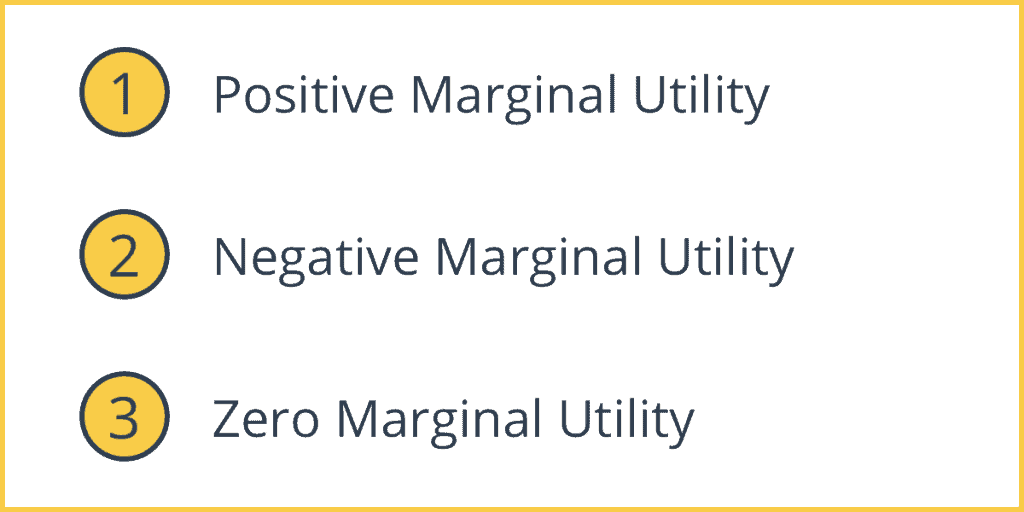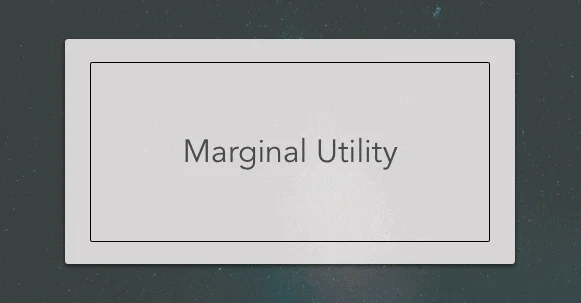The concept of utility measures the satisfaction consumers derive from the consumption of goods and services. Marginal utility is specifically the utility that consumers derive from the consumption of additional units of goods and services.
In other words, it is the difference or change in satisfaction with an extra unit of consumption. (Total utility, by contrast, is the total satisfaction derived from consumption, not just that of an added unit.) Economists use the idea of marginal utility to understand the amount of a good or service that consumers are likely to purchase.
Positive vs. Negative Marginal Utility
Both positive and negative marginal utility can occur. As you might expect, they are the opposite of one another. Positive marginal utility is found when marginal utility increases with the consumption of an additional item. Meanwhile, negative marginal utility takes place when utility decreases with the consumption of one additional item.
Law of Diminishing Marginal Utility
The law of diminishing marginal utility states that the first unit of a good or service that is consumed provides more utility to consumers than any of the consumption that follows. This means that the utility provided by consuming a first unit of a good or service will be higher than subsequent units of that good or service.
Example of Diminishing Marginal Utility
Here’s a straightforward example: the utility from eating your first sandwich at lunch is much greater than that of the fifth sandwich you consume. When you’re eating that fifth sandwich, then you are probably no longer hungry, so not getting much satisfaction, if any, out of eating it. And if the fifth sandwich makes you feel sick, that means you’re experiencing negative marginal utility, where your total utility is actually decreasing as a result of this consumption.
Types of Marginal Utility

Forms of marginal utility are based on the effect of additional consumption on total utility (see the definition of total utility above):
1. Positive Marginal Utility
When buying extras of an item provides more satisfaction, this is considered to be a situation of their providing positive marginal utility. For instance, a buy-two-get-one-free offer for something like cashmere sweaters would be a case of positive marginal utility, because buying two sweaters means you get a third sweater.
2. Negative Marginal Utility
When more of an item is not only not beneficial, but actively harmful or has negative effects, this is a case of negative marginal utility. For instance, if you are prescribed a certain dose of a medication that is beneficial to your health, taking more than this dose can actually have negative effects.
3. Zero Marginal Utility
Zero marginal utility occurs when purchasing additional units of an item provides no more utility, but it is also not actively detrimental as in the case of negative marginal utility.
How to Calculate Marginal Utility
In order to calculate marginal utility, figure out the total utility of consuming a certain number of units of the good or service. For instance, you might buy a sandwich, which you’re willing to pay $10 for. Now you want a second sandwich. But after you’ve eaten the first sandwich, you’re not quite as hungry, so you’re not willing to pay as much for another because it will not provide as much satisfaction as the first—the maximum you’ll pay is roughly $5. This means the total utility for the two sandwiches is $15.
Once you’ve done this, figure out the total utility of consuming another quantity of that same good. In order to derive the marginal utility, you’re going to have to use two measurements of total utility and find the difference between the two. To go back to our sandwich example, let’s say you’re still somewhat hungry so you would only pay $3 for the third sandwich and $2 for the fourth sandwich. The total utility of all four sandwiches, then, is $20.
Marginal Utility Formula

To calculate the marginal utility based on these two total utility numbers, find the difference in their total utility. Then divide that difference in total utility by the difference in units. Here’s how that would look for our example:
- Difference in total utility: $20 – $15 = $5
- Difference in units (number of sandwiches): 4 – 2 = 2
- Dividing difference in total utility by difference in units: $5 / 2 = $2.50
This number ($2.50) is the average value of the utility of each extra sandwich between the second and fourth sandwich purchased and consumed.
The formula looks like this:
Difference in total utility / Difference in units = Average marginal utility
To break it down further:
Difference in total utility = Total utility 2 – Total utility 1
Difference in units = Number of units 2 – Number of units 1
It’s pretty simple to find out the marginal utility for each additional unit. Use the equation above to find the marginal utility where the change in the quantity of goods consumed is only one.
Marginal Utility Example
Here’s a simple example of how marginal utility works. There are two people purchasing bags of rice. Sally has five bags of rice, and purchases a sixth bag of rice. Her friend George has twenty bags of rice, and purchases one more bag of rice. Sally is gaining greater utility than George as a result of purchasing one additional unit (bag) of rice: her supply of rice is increasing by 20 percent, while George’s supply of rice is only increasing by 5 percent.
What this example illustrates is the way that marginal utility keeps decreasing as a buyer makes more and more purchases. Eventually, when this buyer no longer has any use (or, in other words, no longer derives any utility) from owning an additional unit of the good or service, the marginal utility of purchasing another unit has declined to zero.
In another example, you might want to purchase and eat three cookies. After the third cookie, you are completely full and satiated, so purchasing a fourth cookie would not provide you with any additional satisfaction (this is a case of zero marginal utility). And if you buy and eat a fifth cookie, you might get a stomachache, which would not only provide any satisfaction but would also be detrimental—making it a situation of negative marginal utility.


Marginal Utility Example: the percentage use in the example was off. it states that both would have a 5% gain after buying the next bag of rice. this may be old but i was going to use this in my class and noticed the typo
Thank you for your feedback. I will correct it
sir i am reading microeconomics for knowledge, i observe that TOTAL UTILITY means full satisfaction and it is absolute for one individual’s particular product and in fixed conditions then how can it be reduced due to negative marginal utility and in my view the -ve marginal utility should be ignored ?